Library of Congress's Blog, page 8
January 17, 2025
Kelsey Corlett-Rivera, Librarian of Congress Award Winner
Kelsey Corlett-Rivera, an international language librarian for the National Library Service for the Blind and Print Disabled, received a 2024 Librarian of Congress Award for expanding acquisition and discoverability of accessible books.
Tell us about your background.
I grew up on a ranch outside a small town in western Montana. I moved to Cambridge, Massachusetts, for college, where I completed my undergraduate studies at Harvard University, majoring in Spanish and Italian. I had my first library job there, barcoding books in the basement of the Harvard Law School Library.
After college, I worked as a translation project manager, first at the State Department and later in the private sector.
I returned to libraries through the Master of Library Science program at the University of Maryland, where I ended up working as a romance language subject specialist for a decade. For my last few years at UMD, I was also the head of the Research Commons, which provided specialized research support for faculty and graduate students.
What brought you to the Library, and what do you do?
I was interested in shifting away from academia but wanted to stay in the D.C. area. So, I had my eye on jobs at the Library before finally applying for my current role as an international language librarian with the National Library Service for the Blind and Print Disabled.
My main job at NLS is selecting books in non-English languages (primarily Spanish, but also less widely spoken languages from Albanian to Zulu) to add to our collection in accessible formats like audio and braille.
NLS’ collection is similar to that of a large public library, so I mostly select popular reads and some informational books.
I also manage our exchange of accessible books across international borders under the provisions of the Marrakesh Treaty, an international agreement that facilitates such exchanges by organizations serving people who are blind, visually impaired or print disabled.
What are some of your memorable Library moments?
I was very proud to have been one of the primary organizers of a seminar this summer for the Libraries Serving Persons with Print Disabilities Section of the International Federation of Library Associations and Institutions. LPD is made up of representatives from libraries and other organizations supporting people who are blind or print disabled.
NLS leveraged a Friends of the Library grant to sponsor attendance by library professionals from 16 developing countries, many of whom had never had the opportunity to attend an IFLA-LPD event. Overall, the seminar brought together nearly 200 in-person and virtual attendees from 37 countries.
I was also thrilled to receive a Librarian of Congress Award this past spring for my work on Marrakesh Treaty exchanges; it was great to be recognized as part of such an illustrious crowd!
What do you enjoy doing outside of work?
Currently, my main pastime is driving my kids (I have two boys, ages 7 and 11) to soccer. But I also enjoy camping, going to concerts, traveling as much as possible and reading sci-fi in my limited spare time.
What is something your co-workers may not know about you?
Through 4H, I showed my family’s Angus cattle at the county fair every year when I was growing up!
Subscribe to the blog— it’s free!
January 14, 2025
Washington’s Plot to Kidnap a British Prince
–This article also appears in the January-February issue of the Library of Congress Magazine.
The plot: Under the cover of darkness, a crew of armed soldiers rows across the Hudson River, enters New York City, kidnaps the king of England’s son and delivers him to Congress as a prisoner.
The mastermind: Matthias Ogden, a Continental Army officer serving under George Washington during the Revolutionary War.
The target: Prince William, the 16-year-old son of King George III now serving as a midshipman in the Royal Navy.
As the king’s third son, William held little hope of inheriting the throne. So, at age 13, he had joined the navy and, in September 1781, sailed into New York harbor with a squadron under Adm. Robert Digby — the first British royal ever to set foot in America.
The British controlled the city, and loyalists to the crown greeted the prince warmly. “When I came on shore I was received by an immense concourse of people, who appeared very loyal, continually crying out ‘God Bless King George,’” he wrote to his father.
Ogden noted William’s arrival with interest.
A member of a politically prominent New Jersey family, Ogden also was a childhood friend of future vice president and Alexander Hamilton nemesis Aaron Burr. Ogden and Burr attended Princeton together and, in 1775, volunteered for Col. Benedict Arnold’s ill-fated expedition against the British province of Quebec. (Ogden appears in the famous John Trumbull painting of the Battle of Quebec — that’s him in the red uniform holding the dying Gen. Richard Montgomery. The depiction, however, is incorrect: Ogden actually was elsewhere on the battlefield at the time of the general’s death.)
Ogden eventually rose to the rank of colonel in the 1st New Jersey Regiment. He was captured by the British, then released in a prisoner swap.
With William’s arrival in New York that September in 1781, Ogden saw an opportunity: Kidnap the prince and use him as leverage to secure the further release of American prisoners. He drafted a plan and, the following March, submitted it to Washington.
“On the first wet night after we are in readiness,” Ogden wrote, he and a crew would cross the Hudson from New Jersey in four whaleboats and “seize on the Persons of the Young Prince” and his companions at their quarters in Hanover Square.
Washington liked the idea.
“The spirit of enterprise so conspicuous in your plan for surprising in their quarters, & bringing off the Prince-William Henry & Admiral Digby, merits applause,” he wrote Ogden on March 28, “and you have my authority to make the attempt.” You can see these and other documents related to the plot in the Library’s “The Two Georges” exhibit, opening in March.
 The first lines of Washington’s letter approving the kidnapping plan. Manuscript Division.
The first lines of Washington’s letter approving the kidnapping plan. Manuscript Division. He added two commands: “treat them with all possible respect” and immediately deliver them to Congress.
American spies in the city, however, later informed Washington that the prince likely was heavily guarded, and he advised Ogden that his scheme probably would not succeed.
Ogden abandoned the plan. By that time, the war was winding down. The British Army had surrendered at Yorktown in October 1781 — the last major land battle of the war — and peace and a new country lay just ahead.
In 1789, Washington took office as the first president of the United States, and Ogden died of yellow fever two years later at age 36. Prince William, meanwhile, continued a distinguished naval career — he served under Lord Nelson and commanded his own ships. When his older brothers died with no heirs, he ascended to the throne in 1830 as King William IV.
Eventually, King William was shown Washington’s letter approving the long-ago plot to kidnap him.
“I am obliged to General Washington for his humanity,” William said, “but I’m damn’d glad I didn’t give him an opportunity of exercising it towards me.”
Several documents related to the affair will be included in the Library’s “The Two Georges” exhibit, opening in March.
Subscribe to the blog— it’s free!
January 10, 2025
George Washington: Land Surveyor
This story also appears in the January-February issue of the Library of Congress Magazine.
George Washington was 11 when his father, a prominent landowner, died. The future founder of the country inherited several things – an imposing physical frame, a sense of civic duty, several parcels of land, 11 enslaved people and an endless, entrepreneurial interest in acquiring ever more land.
Augustine Washington also left behind some surveying tools, which proved to be as useful as anything else. By 15, young George was already surveying land and by 1749, when he was 17, he was working as a professional surveyor.
This employment largely through the connections of his patron, Lord Fairfax, on whose vast Northern Neck Proprietary (a sort of mini colony, controlled by the Fairfax family) the young Washington received most of his work, mapping out nearly 200 new claims. This was good money in the era and an even better opportunity.
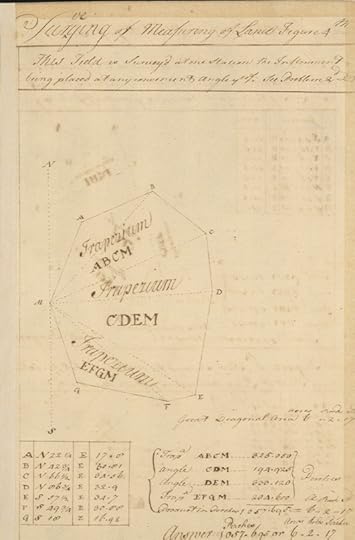 Washington made surveying notes and drawings in his school copybook. This one is titled “Surveying or Measuring of Land,” 1745. Manuscript Division.
Washington made surveying notes and drawings in his school copybook. This one is titled “Surveying or Measuring of Land,” 1745. Manuscript Division.By being one of the first settlers to walk through miles of territory in and around the Blue Ridge mountains, Washington could spot and purchase tracts of land for himself before most anyone else knew what was available. He bought his first property, 1,459 acres in Frederick County, in 1752. It also gave him working knowledge of the Native Americans who had been living for centuries on the land he was now delineating for purchase by white settlers. This was the backdrop for his military career which began a few years later.
Washington worked as a surveyor for three years. The Library preserves, along with the rest of his papers, his survey exercises, notes and orders, as well as his diaries from the period. The mottled leather cover of his 1748 journal, “Journey Over the Mountains,” still bears his handwriting and part of the metal hasp that would have locked it.
It will be on the display in a new exhibit “The Two Georges,” opening in March, which examines the overlapping worlds of Washington and King George III.
Washington never formally worked as a surveyor again, but he surveyed and mapped many of his own vast holdings, including some of the more than 52,000 acres spread across five states left behind in his will. He was surveying land near Difficult Run, a tributary of the Potomac River in northern Fairfax County, a property he hoped to buy, just a few weeks before his death in 1799.
Subscribe to the blog— it’s free!
January 8, 2025
David Rubenstein, Chair of the Library’s Madison Council, Awarded Presidential Medal of Freedom
On Saturday, Jan. 4, Library of Congress James Madison Council chair David M. Rubenstein was awarded the Presidential Medal of Freedom at the White House. This is a crowning achievement for his passionate support of our nation’s history and culture and the arts.
David’s exemplary philanthropy has been a powerful tool for driving transformative change at the Library of Congress and many other institutions across the nation. The tangible benefits of his generosity will be evident to library patrons decades into the future.
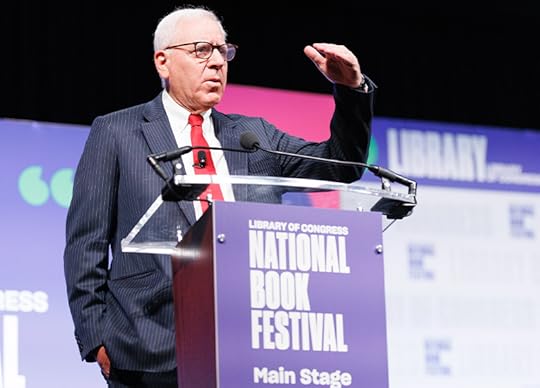 David Rubenstein on the Main Stage at the 2024 National Book Festival. Photo: Shawn Miller.
David Rubenstein on the Main Stage at the 2024 National Book Festival. Photo: Shawn Miller.David’s involvement with the Library dates back 20 years to when he joined the James Madison Council, the Library’s signature philanthropic support group. He has led the council since 2014. His commitment to amplifying our mission of connecting the Library to ALL Americans is evident in the projects he has supported.
Recently, he was the sole benefactor of the David M. Rubenstein Treasures Gallery, which opened in June 2024. This signature gift to the Library’s comprehensive campaign has made possible the first-ever, permanent treasures gallery. The Rubenstein Gallery offers visitors a window into the Library’s vast collections by creating a public space where visitors can see firsthand these fascinating and special items in rotating, thematic exhibitions.
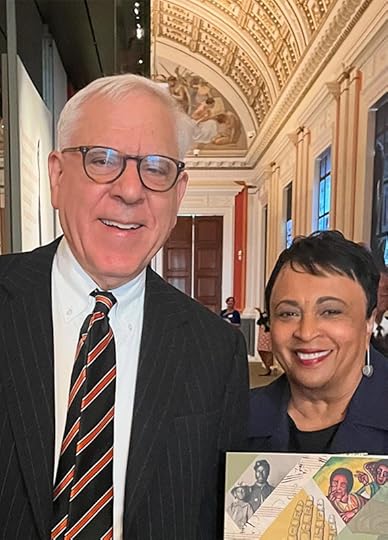 David Rubenstein and Carla Hayden at the opening of the Library’s David M. Rubenstein Treasures Gallery.
David Rubenstein and Carla Hayden at the opening of the Library’s David M. Rubenstein Treasures Gallery.David’s fervent commitment to fighting illiteracy has resulted in his support of two signature programs at the Library, the National Book Festival and the Library of Congress Literacy Awards.
The NBF is an annual free literary event that brings together bestselling authors, poets and illustrators for a daylong celebration of reading through author talks, panel discussions, book signings and other activities. Launched in 2001, the festival has become one of the most prominent literary events in the nation and attracts tens of thousands of booklovers each year.
David helped establish the Literacy Awards in 2013. The awards honor organizations that work to expand literacy and promote reading through exemplary and innovative strategies. Over the past decade, this program has awarded more than $3 million in prizes to over 150 institutions working in 38 countries.
Through the years, David has supported major exhibitions at the Library, including “Mapping a New Nation: Abel Buell’s Map of the United States,” the first map of the newly independent United States compiled, printed and published in America by an American. He also supported the exhibition “First Among Many: The Bay Psalm Book and Early Moments in American Printing,” featuring both the Library’s and David’s copies of the Bay Psalm Book.
David’s tireless advocacy allows us to continue to be “A Library for All” and a vibrant center of knowledge and creativity for members of Congress and their constituents. President Thomas Jefferson said, “There is a debt of service due from every man to his country, proportioned to the bounties which nature and fortune have measured to him.” David is truly the embodiment of this patriotic philanthropy.
So, the Presidential Medal of Freedom is a fitting and deserving honor to a man who exemplifies the American spirit of generosity, creativity and leadership. David, thank you for protecting history and for being a champion for literacy and reading. Congratulations!
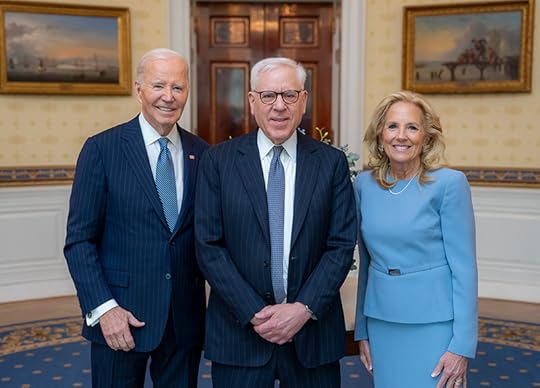 President Joe Biden, David Rubenstein and Dr. Jill Biden at the White House ceremony. Photo: Courtesy of the White House.
President Joe Biden, David Rubenstein and Dr. Jill Biden at the White House ceremony. Photo: Courtesy of the White House.Subscribe to the blog— it’s free!
January 3, 2025
My Job: Lara Szypszak
Lara Szypszak is a reference librarian in the Manuscript Division.
Tell us about your background.
I was born in Concord, New Hampshire, and moved to Chapel Hill, North Carolina, when I was 15. Both locations had a major impact on me, so I have a little bit of an identity crisis when I hear either a Southern drawl or a New England accent.
I completed my undergraduate and first graduate degrees at UNC Chapel Hill, where I studied history and Slavic languages and literatures, specializing in Polish language and literature.
This subject area brought about some really cool opportunities, including working at the Zachęta National Gallery of Art in Warsaw, Poland, and serving as a fellow at the United States Holocaust Memorial Museum.
I didn’t picture myself becoming a librarian, but looking back, I should have seen the signs. My first job was working the circulation desk at the UNC’s Music Library, which was a nice fit since I had trained as a classical violinist from a very young age.
What brought you to the Library, and what do you do?
When I finished graduate school, I took a break and lived in Poland while applying for jobs. That’s when the Library somehow called me for an interview. Well, sort of … I didn’t have international phone access at the time, so I’m grateful the head of the Prints and Photographs Reading Room tracked me down (I clearly remember receiving her email on a night bus to Gdansk).
I started as a reference technician in P&P in 2015. Since then, I have held details in the Music Division’s Concert Office and as an acting supervisor in the Digital Scan Center as a part of the Leadership Development Program.
While working at the Library, I also earned my master’s degree in library and information science remotely from the University of South Carolina.
I’ve been in the Manuscript Division as a reference librarian since 2018, where I wear many hats. But my primary role is to serve patrons in person and remotely. I also serve as the division’s webmaster, lead orientations and tours and carry out many “other duties as assigned.”
It never gets old walking through the stacks and seeing such big names on the shelves. We sometimes joke that the boxes talk to each other at night: “What must Margaret Mead be saying to ole’ Harold Ickes?”
What are some of your standout projects?
I’m approaching 10 years at the Library, so there are many projects I’ve been fortunate enough to be a part of.
Lately, I’ve been excited by the work I’ve been doing with reading room webpage migrations. Not only am I soaking up all the new technical skills, but I’m also being challenged to articulate the work we do with collections and the public in a way that enables designers and digital specialists to translate that information into a product that serves our users well.
I find the work particularly engaging when it crosses service unit borders and I get a chance to interface with and learn from folks in the Office of the Chief Information Officer, the Digital Collections Management and Services Division and other reading rooms.
On a different note, I have had an absolute blast over the years serving as a talent and author escort for the Gershwin Prize concert and the National Book Festival. Not only do I have some wild stories about some of our most beloved celebrities, but I’ve also come away from those experiences with phenomenal friends.
What do you enjoy doing outside of work?
I’ve recently been cultivating my “mountain lady” persona. My partner bought an 1855 cabin on the side of a mountain along the Potomac River, and we get a lot of pleasure in cultivating our garden, tinkering in the workshop/barn and sitting on the back porch with our “Tennessee cattle mutt” (we made that up) named Finn, looking out at the Appalachian Mountains.
What is something your co-workers may not know about you?
That’s a tough one since I’m not exactly known for keeping things to myself. … But I definitely love to travel. I’ve visited 18 countries so far and have no plans of stopping there!
Subscribe to the blog— it’s free!
December 31, 2024
Here’s to a Punchy New Year’s Toast!
This is a guest post by Jennifer “JJ” Harbster, culinary specialist and head of the Library’s Science Section.
Here’s to a happy new year, everyone!
This is the kind of thing you say when making a toast at midnight tonight, but what’s in the glass? How about a vintage punch not just from days gone by … but centuries gone by?
Ever the faithful public servant, I spent some time getting to know punch recipes from the Library’s digitized collection of Pre-Prohibition U.S. mixology books with the goal of inspiring readers to get in touch with history and to practice the art of a flowing punch bowl.
Here’s a quick bit of history, with which you can dazzle your guests.
No one really knows where or when punches originated. Barroom historian David Wondrich in his popular work, “Punch” (2010), suggests the word likely comes from the puncheon, a barrel or cask, used to transport rum from the Caribbean to England. Wondrich suggests that the popularity of the drink can be attributed to sailors, who ran out of beer and wine on their journeys and concocted an “artificial wine from spirits,” mixing up what was on hand to create a new drink. There’s also a bit in the historical record connecting the word “punch” to the Hindu word paanch (or paunch), which means five (for the five elements often included).
Traditional punch bases use rum, brandy or both. Wine and champagne are also common ingredients, and there are also gin and whiskey punches. Exploring punch recipes of the past also introduces us to forgotten beverages such as Catawba wine, made from an early 19th century varietal red grape indigenous in the Northwest United States, and Arrack, one of the world’s oldest distilled beverages, originally made from rice in Indonesia or palm (coconut) sap in India.
The names of punches are often geographical (e.g. Canadian Punch), but they can also be descriptive (e.g. Orange Punch). They can be named after an establishment (e.g. Yale College Punch) or person (e.g. Daniel Webster Punch). And some names are just curious, such as Gothic Punch.
Over the centuries, punch has evolved and become more polished, even non-alcoholic, so there’s plenty for teetotalers.
Okay, ready? Here are three of my favorites for this season. You’ll notice some ingredients that are no longer available and it’s fine to swap in modern ingredients or substitutes. But do remember those five elements that make a punch: spirits, water/ice, sugars, acid, and spice. When all else fails, follow your palate and alcohol tolerance. And, as always, drink responsibly and in moderation.
 Recipe: Joseph Gibson, “Scientific Bar-Keeping,” 1884. Science Section.
Recipe: Joseph Gibson, “Scientific Bar-Keeping,” 1884. Science Section.Let’s start with New Year’s Punch. Joseph Gibson’s 1884 guide on “Scientific Bar-keeping” features a recipe that reuses Professor Jerry Thomas’ 1862 Rocky Mountain Punch, which Thomas had originally described as a “splendid punch for a New Year’s Day.”
These recipes are boozy and include champagne, rum and a pint of maraschino, a cherry liqueur. In many punch recipes, including this one, you will see a call for loaf sugar. This is sugar that is hard and often conical in shape. (This was a popular way to sell sugar prior to the 20th century.) A simple substitute is use granulated or castor sugar, or rocky candy as Thomas suggests. Dress the punch with lemon or orange slices (or both), and Malaga grapes if available (if not, any sweet grapes will do, the sweeter the better).
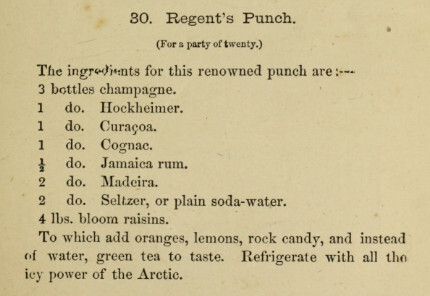 Recipe: Jerry Thomas, “Bar-tenders Guide,” 1862. Science Section.
Recipe: Jerry Thomas, “Bar-tenders Guide,” 1862. Science Section.Next up is Regents Punch, a “renowned punch” from Professor Jerry Thomas, the father of mixology in the U.S., included in his 1862 “Bar-tenders Guide.” This is an exceptionally boozy medley that incorporates champagne, rum, wine (red and white), curaçao and cognac.
If you follow his recipe, note his uses of the abbreviation ‘do’ (i.e. ditto) instead of writing “bottle” after each ingredient. Should you not have a bottle of Hockheimer on hand, a Reisling will do. And you can substitute a sweet sherry or port for Madiera wine. Don’t have four pounds of Bloom Raisins? You can use any plump raisins and as many of them as you think your guests can handle.
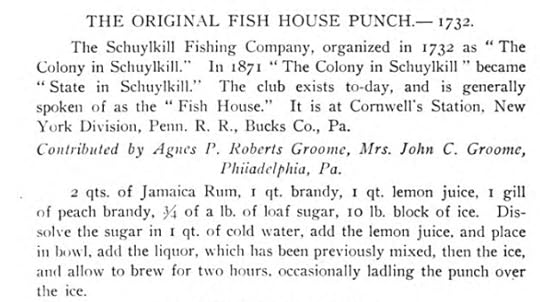 A recipe that bills itself as the 1732 original of the Fish House Punch. Science Division. Recipe: “Famous Old Receipts used a Hundred Years or more in the Kitchens of the North and South,” 1906. (Cookbooks of era used the term “receipts” instead of “recipe.”)
A recipe that bills itself as the 1732 original of the Fish House Punch. Science Division. Recipe: “Famous Old Receipts used a Hundred Years or more in the Kitchens of the North and South,” 1906. (Cookbooks of era used the term “receipts” instead of “recipe.”)Our final holiday entry, the Fish House Punch, was suggested by my mentor and former head of the Library’s Science Section, Constance Carter. She tells a hilarious story of making this for the American Library Association’s annual meetings between 1967 and 1976. She would pack her suitcase full of all the accruements needed, send a box of champagne to the hotel and rent a punch bowl. She made the punch in her suite (she kept it chilled in the bathtub) and after a day of presentations, she invited conference attendees to come by and sip.
The Fish House Punch is an early 18th century creation that came from the one of the oldest social and fishing clubs in the U.S., the Colony in Schuylkill (later named the State in Schuylkill), located near present day Philadelphia and established in 1732.
Any way you look at it, a punch bowl punch is a perfect way to bring people together, so let’s raise our cups to this tradition and welcome the shared experience.
Subscribe to the blog— it’s free!
December 29, 2024
Jimmy Carter, Nation’s 39th President, Passes Away at 100
Former U.S. President Jimmy Carter, whose single term in the Oval Office gave way to a long, Nobel Peace Prize-winning post-presidential career as a humanitarian, diplomat, author and Sunday School teacher, died today. He was 100.
Carter, the nation’s 39th president, served from 1977 to 1981. He was a devout Christian and a famously kind man. In addition to his international peacekeeping missions, he spent much of his retirement with his wife, Rosalynn, helping to build houses for the disadvantaged with the charity Habitat for Humanity. The Carter Center, established by the couple, describes its international mission as “Waging Peace. Fighting Disease. Building Hope.”
“President Jimmy Carter was the personification of the American spirit – compassionate, humanitarian, and peacemaker,” said Carla Hayden, Librarian of Congress. “His lifelong work in public service helped shape this world into a better one and inspired generations of people who seek positive social change. Our hearts are with the Carter family.”
Rosalynn Carter passed away on Nov. 19, 2023, at the age of 96. The Carters were married for 77 years.
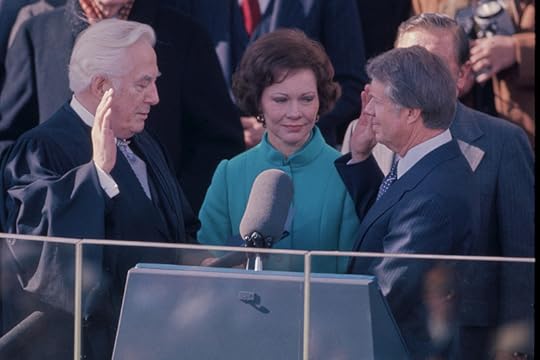 Jimmy Carter takes the oath of office on Jan. 20, 1977, with Supreme Court Chief Justice Warren E. Burger swearing him in as Rosaylnn Carter looks on. Photo: Bernard Gotfryd. Prints and Photographs Division.
Jimmy Carter takes the oath of office on Jan. 20, 1977, with Supreme Court Chief Justice Warren E. Burger swearing him in as Rosaylnn Carter looks on. Photo: Bernard Gotfryd. Prints and Photographs Division.The Jimmy Carter Presidential Library and Museum in Atlanta holds his papers and is administered by the National Archives and Records Administration. At the Library, you can find much about Carter’s life and presidency with both a digital resource guide and one for print items. Further, the Manuscript Division holds the papers of Zbigniew Brzezinski, Carter’s national security adviser; Madeleine Albright, who served on the National Security Council staff; and Harold Brown, Carter’s secretary of defense.
Carter was born in Plains, a small town in southwest Georgia, in 1924, into a family that ran a peanut farm. (Trivia: He was the first president born in a hospital.) After graduating from the U.S. Naval Academy, he served in the Navy for seven years, reaching the rank of lieutenant and serving primarily on submarines. But after his father died in 1953, he took an honorable discharge and returned home to manage the family farming operation. He went into politics as a Democrat, serving in the Georgia state legislature in the 1960s, when the civil rights movement was at its peak. He was Georgia’s governor from 1971 to 1975.
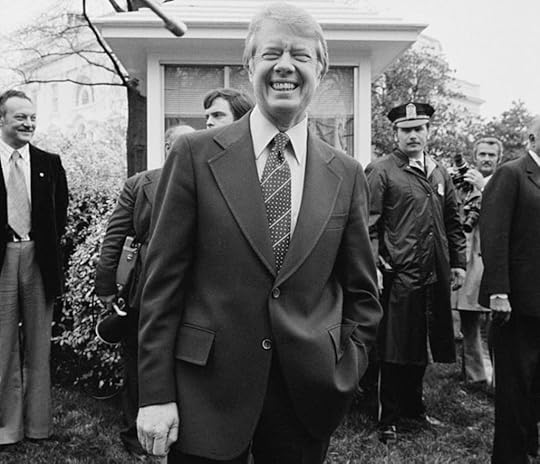 President Jimmy Carter during Egyptian President Anwar Sadat’s historic 1977 visit to the White House. Photo: Marion S. Trikosko. Prints and Photographs Division.
President Jimmy Carter during Egyptian President Anwar Sadat’s historic 1977 visit to the White House. Photo: Marion S. Trikosko. Prints and Photographs Division.After his presidency, he worked as a peacemaker in many international conflicts, including the Bosnian war, but also stayed close to home, teaching Sunday school classes at the tiny Maranatha Baptist Church back in Plains.
He was awarded the 2002 Nobel Peace Prize for his “decades of untiring effort to find peaceful solutions to international conflicts, to advance democracy and human rights, and to promote economic and social development.” He was still helping to build houses for Habitat into his mid-90s, dressing in the work jeans, boots and a T-shirt given to all volunteers.
David Rubenstein, chair of the Library’s Madison Council, served in the Carter administration from 1977 to 1981 as deputy assistant to the president for domestic policy.
“President Carter lived an incredibly full life, and served his country remarkably well as a naval officer, president, and global citizen and advocate for human dignity, racial and gender equality, and democratic values,” Rubenstein said. “We shall not see another like him for generations, if ever. No doubt, he is already telling God how things might be rearranged in heaven to create greater fairness and civility.”
Subscribe to the blog— it’s free!
December 23, 2024
Carla Hall’s Childhood Christmas
This is a guest post by chef Carla Hall, the bestselling author of “Carla Hall’s Soul Food: Everyday and Celebration.” She co-hosted the Emmy-winning “The Chew” for seven seasons.
When I think back to Christmases growing up in Nashville, one of my most cherished memories is the drive out to Lebanon, Tennessee. Every year, my mom, sister, and I would make that 30-mile trip to my grandparents’ house—Doc and Freddie Mai Glover’s—for the holiday. It was a tradition that filled me with excitement, not only for the presents but for the incredible food my Granny would prepare.
That time in my life is the inspiration behind my children’s book, *Carla and the Christmas Cornbread*. Food, family, and love were all wrapped together during those early days, and that’s the story the book tells. In reality, though, our Christmas table wasn’t just for my immediate family—cousins, aunts, uncles, and other relatives would come from all over Tennessee, New York, and Michigan, filling the house with energy and laughter.
One of my fondest memories is how Granny would wait until we arrived to start making her famous cornbread. She made it fresh, and her cinnamon butter really took it over the top—just butter, powdered sugar, cinnamon, and a splash of vanilla extract. You had to eat it hot, right out of the oven.
And then there were her yeast rolls. She always placed the dough in the warmest spot in the house, usually near a radiator, to let it rise. The smell of those rolls filled the whole house throughout the day. That memory stuck with me so much that to this day, I always add a little extra yeast to my bread recipes, trying to recapture that magic.
Dinner at Granny and Doc’s was always a feast. My grandfather was a doctor, and in those days, many people didn’t have cash to pay him. Instead, they’d bring food—hams, turkeys, and even fresh produce from their gardens. So, our Christmas table was overflowing with abundance. Granny’s pickled condiments, like cucumbers and onions with a touch of dill, were served alongside peeled, sliced tomatoes. There were always her mixed greens—collards and mustards—and candied sweet potatoes with marshmallows for the kids.
Of all the dishes, her five-flavor pound cake with boiled custard was my favorite. Years later, when I went to culinary school, I learned that what we called “boiled custard” was actually crème anglaise. But to me, it will always be boiled custard, and that cake will always remind me of her.
The day wasn’t just about food, though. My grandfather would collect coins throughout the year, and on Christmas Day my sister and I would pour them out onto the floor to divide up. We’d start with the quarters—one for her, one for me—and work our way down to the pennies. Then, we’d put the coins into those little saver books you could get from the bank. I loved those books and wish I’d saved at least one.
By the afternoon, the house was packed with relatives—20 or 30 people at its peak. People were always coming and going, making it feel so festive. Granny had a carousel of candy canes in different flavors. My favorite was lemon, but I’d always grab a peppermint, too.
At the end of the day, we’d get back into the car and head home. We never spent the night; it was just that one perfect day. Those Christmases were special and they always will be. Even now, when I visit Nashville, I still feel like that kid waiting for Christmas. It’s my favorite holiday, a time when old memories mix with new ones, like a recipe that deepens in flavor with each passing year.
Subscribe to the blog— it’s free!
December 17, 2024
Holy “Texas Chainsaw,” it’s the 2024 National Film Registry!
The 2024 class of the National Film Registry breaks out today, featuring recent award-winners, touching indie hits, family films and, perhaps the pick with the most punch, the horror landmark “The Texas Chainsaw Massacre.”
Librarian of Congress Carla Hayden announced the annual list of 25 films today, naming inductees as prominent as “The Social Network,” “No Country for Old Men,” “My Own Private Idaho,” “Beverly Hills Cop” and “Mi Familia” as well as documentaries, student films and cinematic milestones.
“Films reflect our nation’s history and culture and must be preserved in our national library for generations to come,” Hayden said. “This is a collective effort in the film community to preserve our cinematic heritage, and we are grateful to our partners, including the National Film Preservation Board.”
The selections span from 1895, with a silent film created to entice audiences at the dawn of cinema, to 2010, with a film about the dawn of social media. All are judged to be of cultural, historic or aesthetic importance to the nation’s film heritage. The NFR now has 900 titles.
In an interview with the Library, Aaron Sorkin recalled the making of “The Social Network,” about the origins of Facebook, and his collaboration with director David Fincher. Sorkin wrote the screenplay with his trademark rapid-fire dialogue based on the 2009 book “The Accidental Billionaires” by Ben Mezrich.
“It felt like a good courtroom drama to me,” Sorkin said. “I didn’t know it was going to be a lot more than that at the time.”
He compared writing dialogue for the screen to making music.
“Anytime speech is used for the sake of performance, it has all of the same qualities and rules that music does. It is music. It has tone and pitch and rhythm,” Sorkin said. “So what a line sounds like is as important to me as what it means.”
The public submitted more than 6,700 nominations this year. Several selected titles received strong public support, including “Chainsaw,” “Star Trek II: The Wrath of Khan” and “Dirty Dancing.”
Turner Classic Movies will host a television special Wednesday, Dec. 18, starting at 8 p.m. ET to screen a selection of this year’s inductees. Hayden will join TCM host and film historian Jacqueline Stewart, who is chair of the National Film Preservation Board, to discuss the films.
“The wealth of American film history is sometimes rather overwhelming, and people often wonder: How do you recommend this film or that film?” Stewart said. “It’s through a lot of research, conversation and discussion, and it’s through a commitment to showing the true diversity of filmmaking. I’m thrilled that we recognize student films and independent films, animation, documentary and experimental works, as well as feature length narrative drama, comedy, horror and science fiction on the registry this year.”
Five films selected this year include prominent Hispanic artists or themes, and two feature the work of Edward James Olmos: “Mi Familia” and “American Me.” This brings Olmos to eight films on the registry as an actor, and “American Me” is his first appearance as a director.
Director Gregory Nava now has three renowned explorations of the Hispanic experience on the NFR, with “Familia” joining previous selections “El Norte” and “Selena.”
Two films this year also feature actor Cheech Marin: “Up in Smoke” and “Spy Kids,” his first films on the registry. In an interview with the Library, Marin recalled making the Cheech & Chong comedies, including “Smoke.”
“The level of improv that we brought to those movies is what gave it a spontaneity,” Marin said. “And that’s why people thought they were happening for the first time. Because in many instances, it was happening for the first time.”
This year’s complete list, in chronological order:
Annabelle Serpentine Dance (1895)KoKo’s Earth Control (1928)Angels with Dirty Faces (1938)Pride of the Yankees (1942)Invaders from Mars (1953)The Miracle Worker (1962)The Chelsea Girls (1966)Ganja and Hess (1973)Texas Chainsaw Massacre (1974)Uptown Saturday Night (1974)Zora Lathan Student Films (1975-76)Up in Smoke (1978)Will (1981)Star Trek II: Wrath of Khan (1982)Beverly Hills Cop (1984)Dirty Dancing (1987)Common Threads: Stories from the Quilt (1989)Powwow Highway (1989)My Own Private Idaho (1991)American Me (1992)Mi Familia (1995)Compensation (1999)Spy Kids (2001)No Country for Old Men (2007)The Social Network (2010)Subscribe to the blog— it’s free!
December 11, 2024
How Johnny Marks, King of Christmas Hits, Made “Rudolph” a Classic
“Rudolph the Red-Nosed Reindeer” went without a song for years, from the tail end of the Depression through World War II and nearly until the midcentury before a musician named Johnny Marks began to consider it.
Marks studied music in college in the 1920s, penned a good song or two for Guy Lombardo’s orchestra in the late 1930s and had a major hit with “Address Unknown” for the Ink Spots in 1939. He served with distinction during the war and wrote some songs that got noticed, but now he was nearly 40 and looking for a hit.
It was about this time that his sister Margaret married Robert L. May, the guy who had come up with the “Rudolph” story back in 1939. May was an ad writer for Montgomery Ward department store and the company gave away more than two million copies of his 31-page “Rudolph” story as a holiday treat for customers that year. After the war’s paper restrictions ended, they’d given away another three million before letting May have the copyright in 1947.
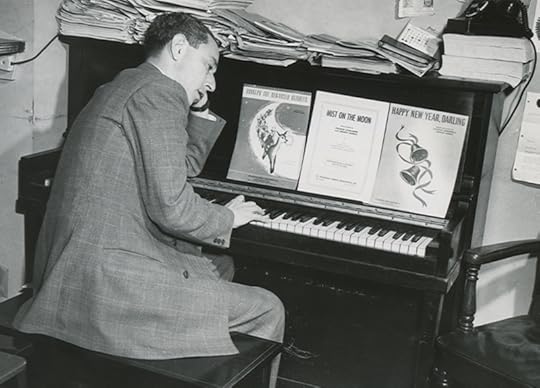 Johnny Marks at his piano with some of his popular sheet music. Photo: Courtesy St. Nicholas Music.
Johnny Marks at his piano with some of his popular sheet music. Photo: Courtesy St. Nicholas Music.Whether May suggested he take a crack at it or on his own whim, Marks looked over his new brother-in-law’s story with a professional eye. It merged “The Ugly Duckling” storyline with the rhyming couplets style of “ ’Twas the Night Before Christmas.” This is how it started:
’Twas the day before Christmas and all through the hills
The reindeer were playing … enjoying the spills
Marks used just over 100 words in his song. He kept the chord progression simple. His first draft didn’t quite work, so he kept tinkering with it. Finally, he offered it to a couple of singers before Western star Gene Autry reluctantly recorded it in 1949 (his wife had to convince him to do so).
“I thought it would be a mild hit,” Marks later told radio broadcaster Mike Whorf.
The rest, as all of the other reindeer might have said, went down in history. Tens of millions of records sold, hundreds of recordings in every conceivable genre, an endless procession of cartoon and TV specials (of which Marks wrote many a score and song).
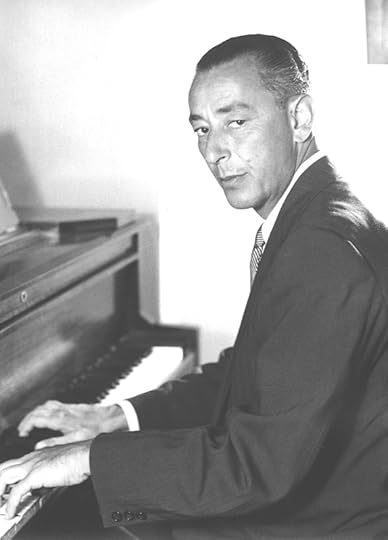 Johnny Marks at the piano in a publicity photo. Photo: Courtesy St. Nicholas Music.
Johnny Marks at the piano in a publicity photo. Photo: Courtesy St. Nicholas Music.It turned out Marks had a particular gift for the Christmas hit. In the coming years, he wrote “A Holly Jolly Christmas,” made famous by Burl Ives; “Rockin’ Around the Christmas Tree,” a perennial hit for pop singer Brenda Lee; and a traditional Christmas carol, “I Heard the Bells on Christmas Day,” adapted from a poem by Henry Wadsworth Longfellow.
The Library preserves much of this history, including placing Autry’s version of “Rudolph” in the National Recording Registry. There’s also the first copyright submission for the “Rudolph” story, a copy of that first 1939 giveaway booklet, handwritten “Rudolph” sheet music and what is likely the only surviving Technicolor nitrate print of Rudolph’s first animated cartoon.
Marks was wistful that people seemed to remember his holiday hits and less of his other work, he said in that 1975 interview with Whorf, preserved now on a disc in the National Library Service for the Blind and Print Disabled. But he didn’t forget what made him famous, and knew that he’d added several standards to the nation’s culture. The name of his music publishing company?
“St. Nicholas Music Inc.”
Subscribe to the blog— it’s free!
Library of Congress's Blog
- Library of Congress's profile
- 74 followers



